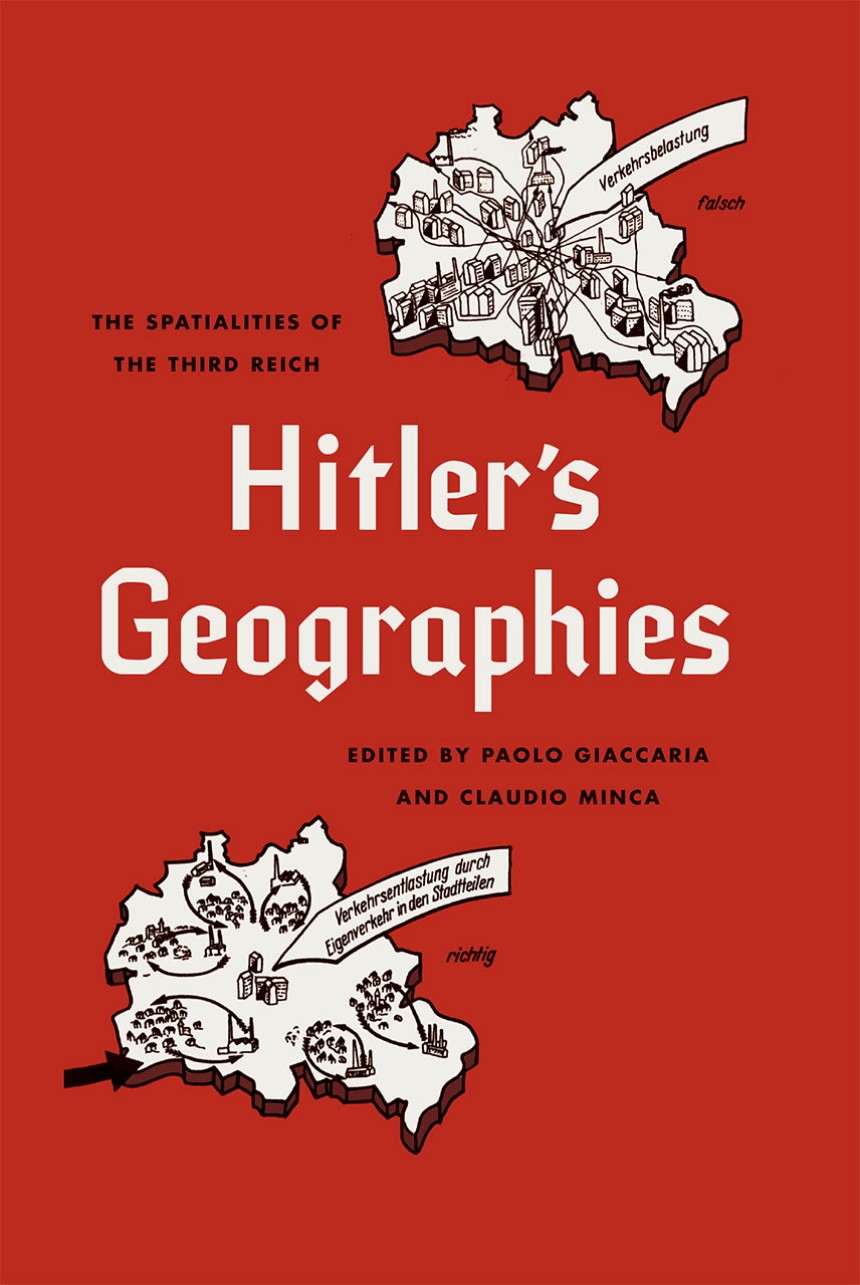Hitler’s Geographies
The Spatialities of the Third Reich
Lebensraum: the entitlement of “legitimate” Germans to living space. Entfernung: the expulsion of “undesirables” to create empty space for German resettlement. During his thirteen years leading Germany, Hitler developed and made use of a number of powerful geostrategical concepts such as these in order to justify his imperialist expansion, exploitation, and genocide. As his twisted manifestation of spatial theory grew in Nazi ideology, it created a new and violent relationship between people and space in Germany and beyond.
With Hitler’s Geographies, editors Paolo Giaccaria and Claudio Minca examine the variety of ways in which spatial theory evolved and was translated into real-world action under the Third Reich. They have gathered an outstanding collection by leading scholars, presenting key concepts and figures as well exploring the undeniable link between biopolitical power and spatial expansion and exclusion.
With Hitler’s Geographies, editors Paolo Giaccaria and Claudio Minca examine the variety of ways in which spatial theory evolved and was translated into real-world action under the Third Reich. They have gathered an outstanding collection by leading scholars, presenting key concepts and figures as well exploring the undeniable link between biopolitical power and spatial expansion and exclusion.
376 pages | 15 halftones | 6 x 9 | © 2016
Geography: Cultural and Historical Geography, Social and Political Geography
History: European History
Reviews
Table of Contents
Introduction: Hitler’s Geographies, Nazi Spatialities: An Introduction
Paolo Giaccaria and Claudio Minca
Spatial Cultural Histories of Hitlerism
1. For a Tentative Spatial Theory of the Third Reich
Paolo Giaccaria and Claudio Minca
2. Holocaust Spaces
Dan Stone
Part II Third Reich Geographies
Section 1 Biopolitics, Geopolitics, and Lebensraum
3. In Service of Empire: Geographers at Berlin’s University between Colonial Studies and Ostforschung (Eastern Research)
Jürgen Zimmerer
4. The East as Historical Imagination and the Germanization Policies of the Third Reich
Gerhard Wolf
5. Race contra Space: The Conflict between German Geopolitik and National Socialism
Mark Bassin
6. Back Breeding the Aurochs: The Heck Brothers, National Socialism, and Imagined Geographies for Non-Human Lebensraum
Clemens Driessen and Jamie Lorimer
Section 2 Spatial Planning and Geography in the Third Reich
7. National Socialism and the Politics of Calculation
Stuart Elden
8. Applied Geography and Area Research in Nazi Society: Central Place Theory and Planning, 1933 to 1945
Mechtild Rössler
9. A Morality Tale of Two Location Theorists in Hitler’s Germany: Walter Christaller and August Lösch
Trevor J. Barnes
10. Social Engineering, National Demography, and Political Economy in Nazi Germany: Gottfried Feder and His New Town Concept
Joshua Hagen
Part II Geographies of the Third Reich
Section 3 Spatialities of the Holocaust
11. Nazi Biopolitics and the Dark Geographies of the Selva
Paolo Giaccaria and Claudio Minca
12. Geographies of Ghettoization: Absences, Presences, and Boundaries
Tim Cole
13. Spaces of Engagement and the Geographies of Obligation: Responses to the Holocaust
Michael Fleming
14. Hello Darkness: Envoi and Caveat
Andrew Charlesworth
Section 4 Microgeographies of Memory, Witnessing, and Representation
15. The Interruption of Witnessing: Relations of Distance and Proximity in Claude Lanzmann’s Shoah
Richard Carter-White
16. A Mobile Holocaust? Rethinking Testimony with Cultural Geography
Simone Gigliotti
17. What Remains? Sites of Deportation in Contemporary European Daily Life: The Case of Drancy
Katherine Fleming
Acknowledgments
Contributor Biographies
Index
Paolo Giaccaria and Claudio Minca
Spatial Cultural Histories of Hitlerism
1. For a Tentative Spatial Theory of the Third Reich
Paolo Giaccaria and Claudio Minca
2. Holocaust Spaces
Dan Stone
Part II Third Reich Geographies
Section 1 Biopolitics, Geopolitics, and Lebensraum
3. In Service of Empire: Geographers at Berlin’s University between Colonial Studies and Ostforschung (Eastern Research)
Jürgen Zimmerer
4. The East as Historical Imagination and the Germanization Policies of the Third Reich
Gerhard Wolf
5. Race contra Space: The Conflict between German Geopolitik and National Socialism
Mark Bassin
6. Back Breeding the Aurochs: The Heck Brothers, National Socialism, and Imagined Geographies for Non-Human Lebensraum
Clemens Driessen and Jamie Lorimer
Section 2 Spatial Planning and Geography in the Third Reich
7. National Socialism and the Politics of Calculation
Stuart Elden
8. Applied Geography and Area Research in Nazi Society: Central Place Theory and Planning, 1933 to 1945
Mechtild Rössler
9. A Morality Tale of Two Location Theorists in Hitler’s Germany: Walter Christaller and August Lösch
Trevor J. Barnes
10. Social Engineering, National Demography, and Political Economy in Nazi Germany: Gottfried Feder and His New Town Concept
Joshua Hagen
Part II Geographies of the Third Reich
Section 3 Spatialities of the Holocaust
11. Nazi Biopolitics and the Dark Geographies of the Selva
Paolo Giaccaria and Claudio Minca
12. Geographies of Ghettoization: Absences, Presences, and Boundaries
Tim Cole
13. Spaces of Engagement and the Geographies of Obligation: Responses to the Holocaust
Michael Fleming
14. Hello Darkness: Envoi and Caveat
Andrew Charlesworth
Section 4 Microgeographies of Memory, Witnessing, and Representation
15. The Interruption of Witnessing: Relations of Distance and Proximity in Claude Lanzmann’s Shoah
Richard Carter-White
16. A Mobile Holocaust? Rethinking Testimony with Cultural Geography
Simone Gigliotti
17. What Remains? Sites of Deportation in Contemporary European Daily Life: The Case of Drancy
Katherine Fleming
Acknowledgments
Contributor Biographies
Index
